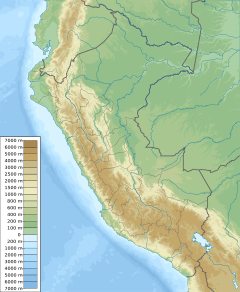Quimsachata (Canchis) facts for kids
Quick facts for kids Quimsachata |
|
|---|---|
| Highest point | |
| Elevation | 3,923 m (12,871 ft) |
| Geography | |
| Location | Cusco Region |
| Parent range | Andes |
| Geology | |
| Age of rock | 4450 BCE |
| Mountain type | Volcano |
Quimsachata is an extinct volcano located in the Andes mountains of Peru. Its name might come from the Aymara and Quechua word kimsa (meaning "three") and the Pukina word chata (meaning "mountain").
This volcano is found in the Cusco Region, in the Canchis Province. It's about 24 kilometers (15 miles) northwest of the town of Sicuani. Quimsachata was formed from two different parts. One part was active about 11,500 years ago, creating a scoria cone and a lava field. The other part was active around 4450 BCE, forming two lava flows and a lava dome.
What is Quimsachata?
Quimsachata is actually a group of two volcanoes: Quimsachata itself and Oroscocha. They are the youngest volcanoes in northern Peru. They are also quite far from the main chain of volcanoes.
Local stories from the Inka people might talk about volcanic activity at Quimsachata. These events could have become part of their creation myths and religious practices. This is interesting because the eruptions happened long before the Inka civilization existed.
Is Quimsachata still active?
As of 2021, the Quimsachata volcano is not being watched by scientists. However, there are plans to set up a system to monitor it. It is currently thought to be a "very low hazard" volcano. This means it is not expected to erupt anytime soon.
The area around Quimsachata is popular with both local and international tourists. There are also important archeological sites nearby.
How Quimsachata Was Formed
Quimsachata was created by a scoria cone and a lava field. It is located near the Vilcanota valley. This part of the volcano erupted about 11,500 years ago.
Oroscocha is a dome with two lava flows connected to it. These lava flows can be as thick as 20 meters (66 feet). The Oroscocha volcano covers an area of about 1.5 square kilometers (0.6 square miles). Oroscocha erupted from a crack in the ground around 4450 BCE. Its lava flow even changed the path of the Vilcanota river.
The rocks that make up Oroscocha are rich in crystals. The dome is darker than the lava flows. Scientists believe the molten rock (magma) that formed these rocks was changed by other types of rock pushing into it while it was still deep underground. Quimsachata itself is made of a type of rock called andesite, which is rich in potassium.
See also
 In Spanish: Quimsachata para niños
In Spanish: Quimsachata para niños


